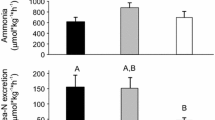Abstract
Analyses of gut contents of freshly collected Ligia pallasii (Brandt) showed that the principal foods were encrusting diatoms, insect larvae, occasional members of the same species, and a variety of red and green seaweeds growing in the upper interiidal tidepool habitat. L. pallasii prefers to eat the green seaweed Ulva sp., and the brown alga Nereocystis luetkeana, when given a choice between several seaweeds, although neither of these forms is normally accessible to the isopods. The absorption (“assimilation”) of food-energy was 78% on a diet of Ulva and 55 to 76% on a diet of N. luetkeana—representative values for an algivorous invertebrate. A correlation analysis on the relationship of feeding preference of L. pallasii with calorific value of 7 potential seaweed foods suggested that feeding preference in this species is related to factors other than energy content of the food. Food preferences of invertebrates are discussed in relation to calorific value, accessibility, and to various nutritional factors.
Similar content being viewed by others
Literature cited
Black, W. A. P.: The seasonal variation in weight and chemical composition of the common British Laminariacease. J. mar. biol. Ass. U.K. 29, 45–72 (1950).
Boolootian, R. A. and R. Lasker: Digestion of brown algae and the distribution of nutrients in the purple sea urchin Strongylocentrotus purpuratus. Comp. Biochem. Physiol. 11, 273–289 (1964)
Carefoot, T. H.: Growth and nutrition of Aplysia punctata feeding on a variety of marine algae. J. mar. biol. Ass. U.K. 47, 565–589 (1967)
— A comparison of absorption and utilization of food energy in two species of tropical Aplysia. J. exp. mar. Biol. Ecol. 5, 47–62 (1970)
Dayton, P. K.: Competition, disturbance, and community organization: the provision and subsequent utilization of space in a rocky intertidal community. Ecol. Monogr. 41, 351–389 (1971).
Dethier, V. G.: Chemical interactions between plants and insects. In: Chemical ecology, pp 83–102. Ed. by E. Sondheimer and J. B. Simeone. New York: Academic Press 1970.
Emlen, J. M.: The role of time and energy in food preference. Am. Nat. 100, 611–617 (1966).
Frei, E. and R. D. Preston: Non-cellulosic structural polysaccharides in algal cell walls II. Association of xylan and mannan in Porphyra umbilicalis. Proc. R. Soc. (Ser. B) 160, 314–327 (1964).
Fuji, A.: Studies on the biology of the sea urchin V. Food consumption of Strongylocentrotus intermedius. Jap. J. Ecol. 12, 181–186 (1962).
Gentry and Wiegert Instruments, Inc: Instructions for the Phillipson microbomb calorimeter, 4 pp. South Carolina: Aiken 1970.
Green, J. M.: Local distribution of Oligocottus maculosus Girard and other tidepool cottids of the west coast of Vancouver Island, British Columbia. Can. J. Zool. 49, 1111–1128 (1971).
Hubbell, S. P., A. Sikora and O. H. Paris: Radiotracer, gravimetric and calorimetric studies of ingestion and assimilation rates of an isopod. Hlth Phys. 11, 1485–1501 (1965).
Leighton, D. L.: Studies of food preference in algivorous invertebrates of Southern California kelp beds. Pacif. Sci. 20, 104–113 (1966).
— and R. A. Boolootian: Diet and growth in the black abalone, Haliotis cracherodii. Ecology 44, 227–238 (1963)
MacArthur, R. H. and E. R. Pianka: On optimal use of a patchy environment. Am. Nat. 100, 603–609 (1966).
Meeuse, B. J. D.: Free sulfuric acid in the brown alga, Desmarestia. Biochim. biophys. Acta 19, 372–374 (1956).
Merriam, H. G.: Sensitivity of terrestrial isopod populations (Armadillidium) to food quality differences. Can. J. Zool. 49, 667–674 (1971).
Miller, M. A.: Comparative ecological studies on the terrestrial isopod Crustacea of the San Francisco Bay region. Univ. Calif. Publs Zool. 43, 113–142 (1938).
Nicholls, A. G.: Studies on Ligia oceanica. I. A. Habitat and effect of change of environment on respiration. B. Observations on moulting and breeding. J. mar. biol. Ass. U.K. 17, 655–673 (1931a).
— Studies on Ligia oceanica. Part II. The processes of feeding, igestion and absorption, with a description of the structure of the foregut. J. mar. biol. Ass. U.K. 17, 675–707 (1931b).
Paine, R. T.: Endothermy in bomb calorimetry. Limnol. Oceanogr. 11, 126–129 (1966).
—: Energy flow in a natural population of the herbivorous gastropod Tegula funebralis. Limnol. Oceanogr. 16, 86–98 (1971a).
— The measurement and application of the calorie to ecological problems. A. Rev. Ecol. Syst. 2, 145–164 (1971b).
— and R. L. Vadas: Calorific values of benthic marine algae and their postulated relation to invertebrate food preference. Mar. Biol. 4, 79–86 (1969).
Paris, O. H. and A. Sikora: Radiotracer analysis of the trophic dynamics of natural isopod populations. In. Secondary productivity of terrestrial ecosystems, Vol. II. pp 741–771. Ed. by K. Petrusewicz. Warsaw-Cracow: Institute of Ecology, Polish Academy of Sciences 1967.
Prus, T.: The assimilation efficiency of Asellus aquaticus L. (Crustacea, Isopoda). Freshwat. Biol. 1, 287–305 (1971).
Reichle, D. E.: Radioisotope turnover and energy flow in terrestrial isopod populations. Ecology 48, 351–366 (1967).
Rigg, G. B. and R. C. Miller: Intertidal plant and animal zonation in the vicinity of Neah Bay, Washington. Proc. Calif. Acad. Sci. 26, 323–351 (1949).
Saito, S.: Structure and energetics of the population of Ligidium japonica (Isopoda) in a warm temperate forest ecosystem. Jap. J. Ecol. 15, 47–55 (1965)
Schafer, R. D. and C. E. Lane: Some preliminary observations bearing on the nutrition of Limnoria. Bull. mar. Sci. Gulf Caribb. 7, 289–296 (1957).
Schooner, T. W.: Theory of feeding strategies. A. Rev. Ecol. Syst. 2, 269–404 (1971).
Soldatova, I. N., E. A. Tsikhon-Lukanina, G. G. Nikolaeva and T. A. Lukasheva: On the transformation of the energy of food in marine crustaceans. [In Russ.]. Okeanologija 9, 1087–1094 (1969)
Watson, J.: Studies on the bioenergetics of certain terrestrial isopods. Ph. D. thesis, University of Durham 1966.
White, J. J.: Bioenergetics of the woodlouse Tracheoniscus rathkei Brandt in relation to litter decomposition in a deciduous forest. Ecology 49, 694–704 (1968)
Author information
Authors and Affiliations
Additional information
Communicated by T. R. Parsons, Vancouver
Rights and permissions
About this article
Cite this article
Carefoot, T.H. Feeding, food preference, and the uptake of food energy by the supralittoral isopod Ligia pallasii . Marine Biology 18, 228–236 (1973). https://doi.org/10.1007/BF00367989
Accepted:
Issue Date:
DOI: https://doi.org/10.1007/BF00367989




